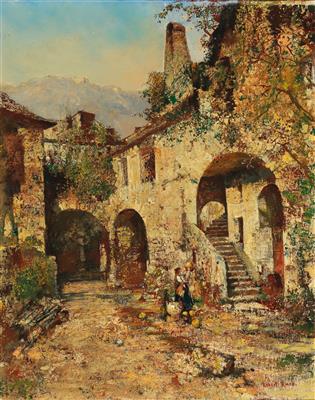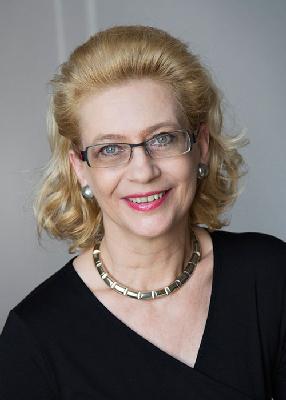Robert Russ

(Vienna 1847–1922)
“Hof in Weissenkirchen a/d Donau”, c. 1917, old title on the reverse, signed Robert Russ, oil on canvas, 69 x 54 cm, framed, (Rei)
Compare:
Robert Russ (1847–1922, Monographie mit Verzeichnis der Gemälde, Kinsky Editionen, Andrea Winkelbauer, Marianne Hussl-Hörmann, p. 209, no. 398f.
The present lot will be included as no. I.455-E in the forthcoming additional volume of the catalogue raisonné
As the Neue Freie Presse put it in his obituary, Robert Russ came from a family “in which the talent for painting was hereditary” (NFP, 22 March 1922, Abendblatt p. 2). His father Franz Russ the Elder was already a successful painter in his own right, and his brother Franz Russ the Younger had also achieved a great deal of artistic prestige. However, Robert Russ did not become one of his father’s pupils. Instead, he moved to the Viennese Academy of Fine Arts at a young age, where he attended the landscape class led by Albert Zimmermann. As soon as 1866, at the age of 19, Russ exhibited his works at the Kunstverein and, one year later, became a member of the Künstlerhaus, where he could be seen regularly from then on. From that point onwards, the star of this talented landscape painter continued to rise. He undertook extensive journeys through Europe and all the lands ruled by the monarchy, with South Tyrol particularly impressing him. From the mid-1870s on, Russ received several official commissions from public bodies, including nine interior paintings for the rooms of the Natural History Museum and a total of 95 drawings for the “Kronprinzenwerk” encyclopedia. Once the Great Gold State Medal had been bestowed upon him in 1891, he had finally received every possible award in Austria. In the eyes of contemporary art critics, Russ was the “master of lighting effects” (J. Langl, Die Jahresausstellung im Wiener Künstlerhaus, in: Kunstchronik N.F. 1, 1890, p. 399). But it is not only his extraordinary skill in lighting that is recognisable in this lot, displaying a courtyard in Weissenkirchen in the Wachau region: another one of Russ’s trademarks can also be seen. He developed a technique with which he was able mechanically to create a crumbling wall on the picture surface. Discussing the high point of his creative period, “Vorfrühling. Motiv aus der Penzinger Au”, Carl von Lützow wrote that it showed “his conscientious approach to drawing, his secure, lively rending, combined with the magic of colours and mood”. (Carl von Lützow, Kunstchronik 22, 1887, p. 499.)
Esperta: Mag. Dimitra Reimüller
 Mag. Dimitra Reimüller
Mag. Dimitra Reimüller
+43-1-515 60-355
19c.paintings@dorotheum.at
23.10.2019 - 17:00
- Stima:
-
EUR 30.000,- a EUR 40.000,-
Robert Russ
(Vienna 1847–1922)
“Hof in Weissenkirchen a/d Donau”, c. 1917, old title on the reverse, signed Robert Russ, oil on canvas, 69 x 54 cm, framed, (Rei)
Compare:
Robert Russ (1847–1922, Monographie mit Verzeichnis der Gemälde, Kinsky Editionen, Andrea Winkelbauer, Marianne Hussl-Hörmann, p. 209, no. 398f.
The present lot will be included as no. I.455-E in the forthcoming additional volume of the catalogue raisonné
As the Neue Freie Presse put it in his obituary, Robert Russ came from a family “in which the talent for painting was hereditary” (NFP, 22 March 1922, Abendblatt p. 2). His father Franz Russ the Elder was already a successful painter in his own right, and his brother Franz Russ the Younger had also achieved a great deal of artistic prestige. However, Robert Russ did not become one of his father’s pupils. Instead, he moved to the Viennese Academy of Fine Arts at a young age, where he attended the landscape class led by Albert Zimmermann. As soon as 1866, at the age of 19, Russ exhibited his works at the Kunstverein and, one year later, became a member of the Künstlerhaus, where he could be seen regularly from then on. From that point onwards, the star of this talented landscape painter continued to rise. He undertook extensive journeys through Europe and all the lands ruled by the monarchy, with South Tyrol particularly impressing him. From the mid-1870s on, Russ received several official commissions from public bodies, including nine interior paintings for the rooms of the Natural History Museum and a total of 95 drawings for the “Kronprinzenwerk” encyclopedia. Once the Great Gold State Medal had been bestowed upon him in 1891, he had finally received every possible award in Austria. In the eyes of contemporary art critics, Russ was the “master of lighting effects” (J. Langl, Die Jahresausstellung im Wiener Künstlerhaus, in: Kunstchronik N.F. 1, 1890, p. 399). But it is not only his extraordinary skill in lighting that is recognisable in this lot, displaying a courtyard in Weissenkirchen in the Wachau region: another one of Russ’s trademarks can also be seen. He developed a technique with which he was able mechanically to create a crumbling wall on the picture surface. Discussing the high point of his creative period, “Vorfrühling. Motiv aus der Penzinger Au”, Carl von Lützow wrote that it showed “his conscientious approach to drawing, his secure, lively rending, combined with the magic of colours and mood”. (Carl von Lützow, Kunstchronik 22, 1887, p. 499.)
Esperta: Mag. Dimitra Reimüller
 Mag. Dimitra Reimüller
Mag. Dimitra Reimüller
+43-1-515 60-355
19c.paintings@dorotheum.at
|
Hotline dell'acquirente
lun-ven: 10.00 - 17.00
kundendienst@dorotheum.at +43 1 515 60 200 |
| Asta: | Dipinti dell’Ottocento |
| Tipo d'asta: | Asta in sala |
| Data: | 23.10.2019 - 17:00 |
| Luogo dell'asta: | Wien | Palais Dorotheum |
| Esposizione: | 12.10. - 23.10.2019 |
Altri oggetti dell'artista
-

Stima:
EUR 40.000,- a EUR 70.000,- -

Stima:
EUR 5.000,- a EUR 7.000,-
